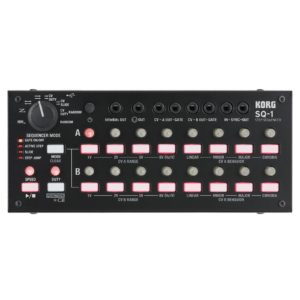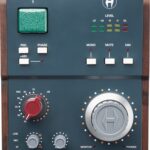Korg released its SQ-1 sequencer originally as a pair with the re-imagined MS-20 synthesizer. Faced with two Volcas, a Monotribe, a Moog Sub 37, and a Teenage Electronics PO-12, I wondered if the device could essentially serve as a sync traffic cop; keeping all five instruments in rhythmic “harmony” suitable for some long-form Berlin School action. Read further to check out the results of my experimentation.
A Closer Look at the Korg SQ-1
At its core, the SQ-1 is a bare-bones 2 x 8 analog sequencer perfect for any synth with a CV input. The unit doesn’t even provide memory for storing sequences; lending itself more to improvisation and experimentation instead of composition. This isn’t a drawback at all.
The SQ-1 features two CV channels (A and B) for sending voltage control and gate signals to connected synths. A separate output is compatible with the littleBits Synth Kit (I haven’t had the time or space to experiment with this yet). Sync I/O, a MIDI out (the 5-pin adapter cable is included), and a USB jack round out the SQ-1’s ports.
The panel of the SQ-1 is dominated by two sets of 8 step knobs and buttons. Simple button presses turn a step on and off, while the associated knob controls the voltage output for that step. Like the Volca series synths, each button also serves another role when holding down the Function button; these are used for controlling the CV range (for compatibility with older synths) and the associated scale.
Speed and Duty knobs and a Start/Stop button handle sequence playback. A Sequencer Mode selector switches between different playback modes, which let you do a variety of things from the simple — like choosing either 8 or 16 step sequences — to the more esoteric, like using Channel B’s knobs to vary the Duty or Slide for each step. This ease of control lends itself well to real-time experimentation with sequences.
The Korg SQ-1 controlling your MIDI Sync
When I bought the SQ-1, I figured it would be nice to have an easy to use analog sequencer always at the ready, but my most important short-term need involved keeping my two Volcas, Monotribe, and PO-12 in sync with the Moog Sub 37 or any other MIDI synth with an arpeggiator. The basic question came down to whether the SQ-1 would send a Sync Clock signal over MIDI when the sequencer wasn’t on. This allows the Moog’s arpeggiator to stay in sync without any SQ-1 sequencer data overriding the arpeggiator.
Needless to say, this worked perfectly. The SQ-1 outputs MIDI clock sync when the sequencer is turned off. Additionally, the Speed knob functions as expected.
I was able to build Berlin School sequences of doom using all five devices. Sync cables were used for the Volcas, Monotribe, and PO-12, while the SQ-1’s MIDI out was connected to the Moog. The next Church of Hed album, Brandenburg Heights, uses this setup extensively.
One issue worth noting involved keeping the Sub 37’s Pitch CV input disconnected when also using the MIDI signal from the SQ-1. With everything connected, it’s difficult getting the Moog to play in key or at the right octave. As an aside, you need to use an expression pedal for the Filter CV!
I’ve had a blast playing around with the SQ-1 sequencer with the Moog, nonetheless. I can’t wait to get some Eurorack gear or the Make Noise 0-Coast in the house to really put the SQ-1 through its paces. The Sub 37’s powerful sequencer and arpeggiator lessens the need for an external sequencer for me. Serving as a sync traffic cop is a perfect role for the SQ-1 for now.





[…] picking up the Korg SQ-1 to serve as a MIDI sync traffic cop between the Volcas, Monotribe, Teenage Electronics PO-12, and […]